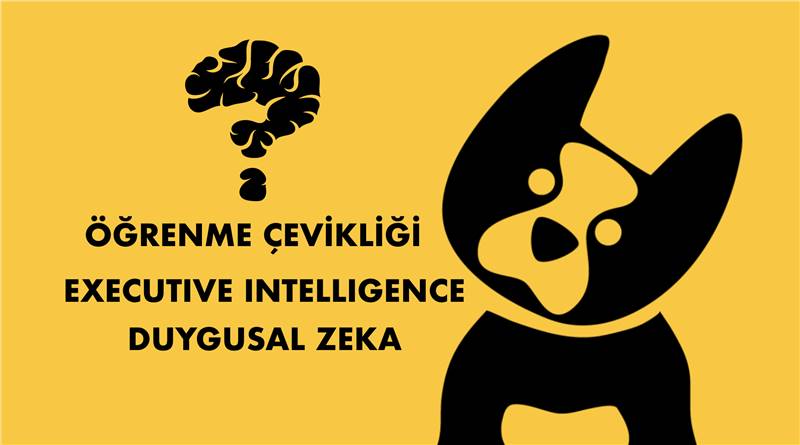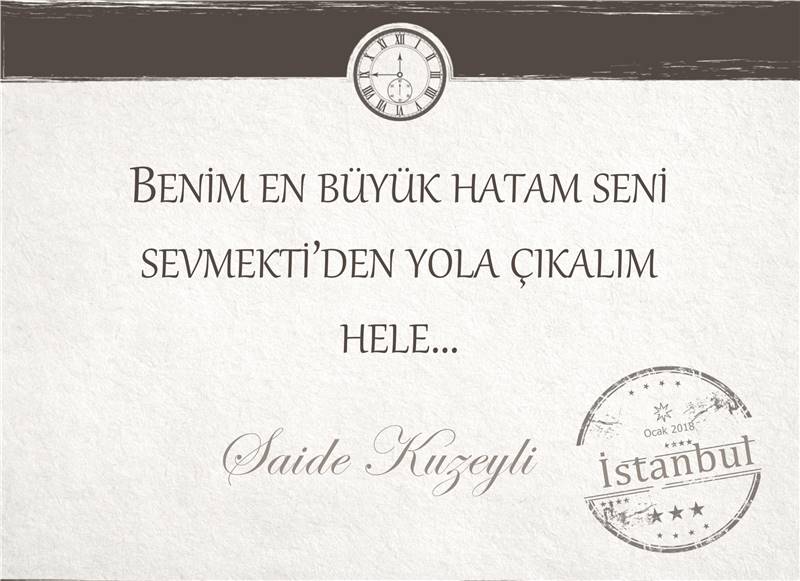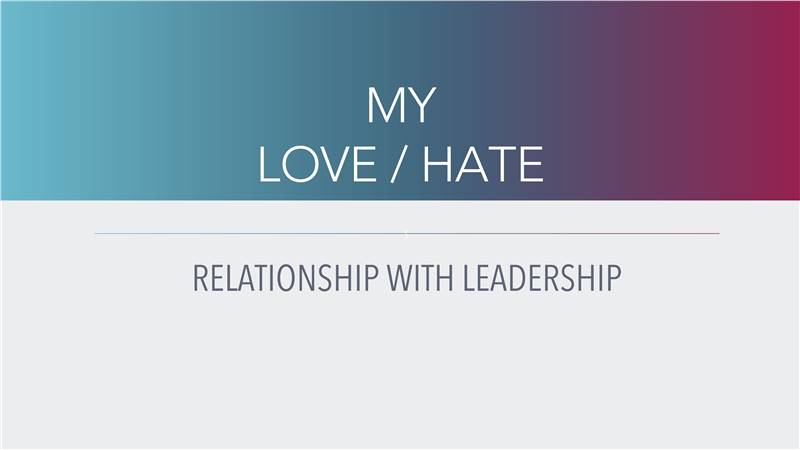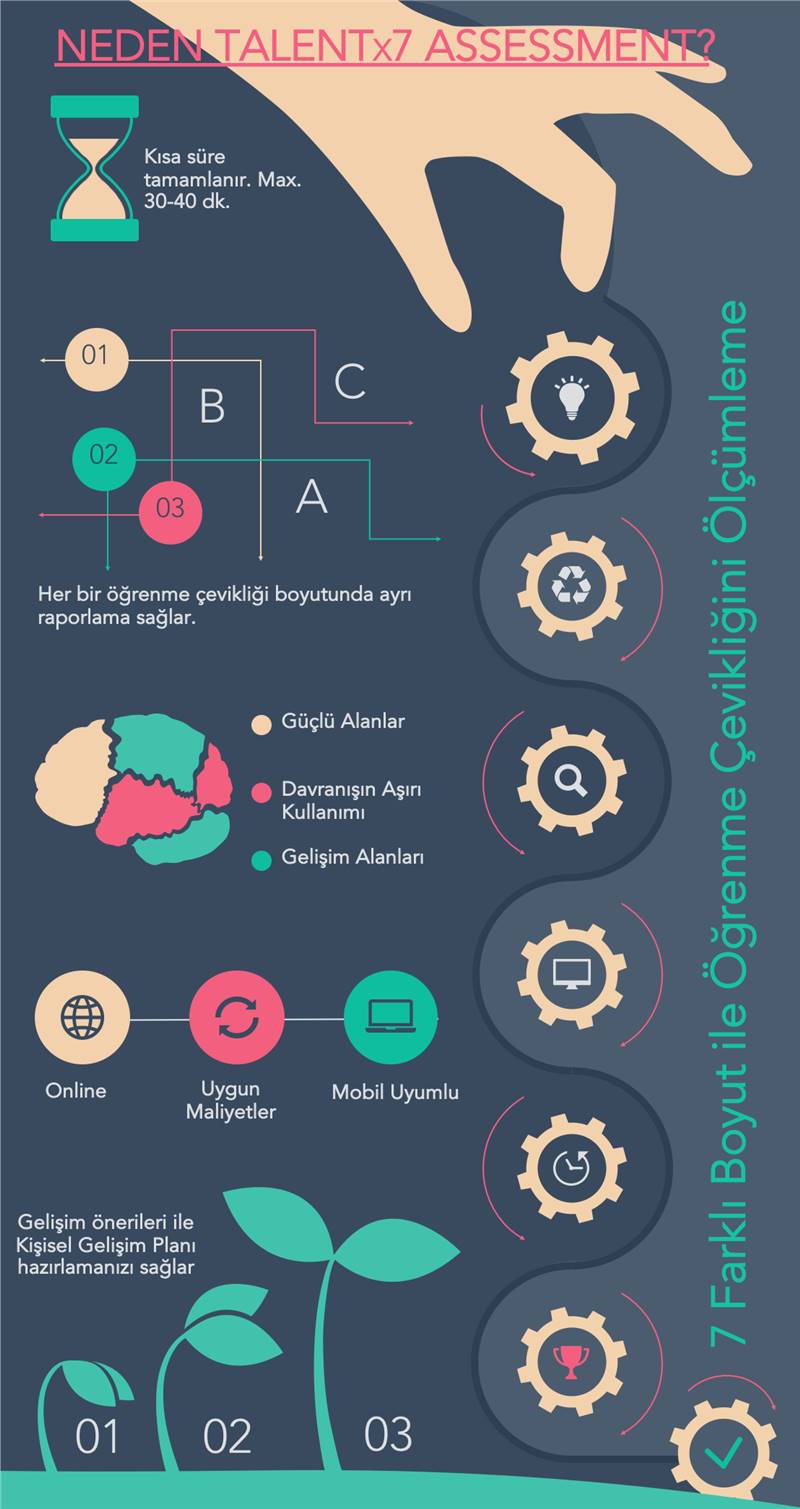Kurumunuzdaki Yetenekleri Keşfetmek için Bilimi Kullanın (II)

Using Science to Identify Future Leaders:
Part III - The TALENTx7 Assessment™ of Learning Agility
Kenneth P. De Meuse, Ph.D.
As mentioned in Part I of this series of whitepapers, many organizations around the globe use learning agility to help make decisions regarding the identification and development of their future leaders. Consulting firms such as Development Dimensions International (DDI), Hay Group, and Korn/Ferry International have been selling various assessments purported to measure learning agility for about a decade. These assessments employ one of three methodologies: (a) structured, behavioral interviews, (b) multi-rater surveys, or (c) online self- assessments. Unfortunately, each consulting firm appears to define and measure learning agility differently.
The table on the next page presents the name of the assessment, its methodology, a definition of learning agility, and what facets are measured for five firms that commonly sell products and services to help organizations identify and develop their high potential talent. In general, all five firms define learning agility in terms of (a) the ability to learn and (b) then apply that learning to new leadership roles in the future. However, DDI stresses “speed of learning” as important, the Hay Group focuses on “readiness to take advantage of developmental opportunities,” and ChangeWise emphasizes “success requiring the consideration of multiple views and priorities.” With regard to measurement, the Center for Creative Leadership (CCL) assesses two facets; ChangeWise, DDI, and the Hay Group assess four; and Korn/Ferry assesses five.
What Do the Scientists Say?
Researchers likewise are not in agreement on how to define – or measure – the construct of learning agility. Some scientists define the construct narrowly and emphasize primarily the speed of learning and behavioral flexibility (DeRue, Ashford, & Myers, 2012); whereas, others define learning agility more broadly and theorize it in terms of a leadership meta-competency (De Meuse, Dai, & Hallenbeck, 2010). The originators of the term, Lombardo and Eichinger, defined learning agility as “the willingness and ability to learn new competencies in order to perform under first-time, tough, or different conditions” (2000, p. 323). They formulated a theoretical framework of learning agility consisting of the following four factors: (a) mental agility, (b) people agility, (c) results agility, and (d) change agility. However, they modified their viewpoint over time, and later added a fifth factor – (e) self-awareness (De Meuse, Dai, Zewdie, Page, Clark, & Eichinger, 2011).
Consulting Firms that Sell Learning Agility Assessments
|
Consulting Firm |
Name of the Assessment | Methodology | Definition of Learning Agility | What is Measured |
|---|---|---|---|---|
| Center for Creative Leadership (CCL) | Prospector® | Multi-rater survey |
Ability to learn and to lead from new experiences and have the ability to apply those lessons to workplace challenges |
Two Facets -Learning to learn -Learning to lead |
| ChangeWise |
Leadership Agility 360™ |
Multi-rater survey | Ability to lead effectively when rapid change and uncertainty are the norm and when success requires consideration of multiple views and priorities |
Three Action Areas -Leading organizational change -Improving team performance -Engaging in pivotal conversations Four kinds of leadership agility -Context-setting agility -Stakeholder agility -Creative agility -Self-leadership agility |
| Development Dimensions International (DDI) | Leadership Potential Inventory (LPI) | Multi-rater survey | Rapidly learns and applies new information to work issues and problems; demonstrates a continuous learning orientation |
Four Facets -Leadership promise -Personal development orientation -Mastery of complexity -Balance of values and results Learning agility is one of the factors of “personal development orientation” |
| Hay Group | Growth Factors Inventory |
-Multi-rater survey -Self-assessment |
Readiness to take advantage of developmental opportunities and to stretch one’s capabilities beyond the current set |
Four Facets -Curiosity and eagerness to learn -Breadth of perspective -Understanding others -Personal maturity |
|
Korn/Ferry International |
LFE™ Choices® viaEDGE™ |
-Behavioral interview -Multi-rater survey -Self-assessment |
Ability and willingness to learn lessons from experience and subsequently apply those lessons to perform successfully in new or first-time situations |
Five Facets -People agility -Change agility -Results agility -Self-awareness |
It is important to remember that learning agility as a construct is less than 15 years old. Relative to other established psychological constructs such as intelligence, motivation, and even leadership itself, which have been studied for decades, learning agility is in its infancy. It continues to evolve. Scholars have debated the extent to which mental ability, willingness, cognitive flexibility, and other facets play a role. For example, if one posits that “speed of learning” is a component of the construct, then intellect might be important (DeRue et al., 2012; Gottfredson, 1997). Yet, some researchers have found intelligence to be largely unrelated to learning agility (Connolly & Viswesvaran, 2002; De Meuse, Dai, & Marshall, 2012). On the other hand, if one postulates that “willingness” is not a component (DeRue et al., 2012; Mitchinson, Gerard, Roloff, & Burke, 2012), then one has to ignore the stream of research findings showing the importance of goal orientation in motivating human learning (Colquitt & Simmering, 1998;
Dweck, 1986). Further, some researchers have specifically emphasized willingness as an important element of learning from experience (Carette & Anseel, 2012; Dominick, Squires, & Cervone, 2010).
As of now, there is no standard definition of learning agility. Therefore, it seems prudent to define learning agility more broadly to capture all of its complexity and nuances, recognizing there may be some loss of conceptual clarity and rigor. In addition, it is important to define learning agility in a way that it adds value to leadership selection and developmental efforts within organizations (Hezlett & Kuncel, 2012). Most scientists, as well as practitioners in consulting firms, agree on the following four points:
1. Conceptualize learning agility in terms of learning from work and life experiences;
2. View it as a multi-dimensional psychological construct;
3. Suggest it can be used as a key predictor of leadership potential; and
4. Recommend that learning agility should be considered as an important element in leadership development.
Hence, for parsimony and to capitalize on the construct’s ongoing utility for leadership identification and development, learning agility is defined as the ability and willingness to learn quickly, and then apply those lessons to perform well in new and challenging leadership situations.
Facets of the Learning Agility Construct
Given the lack of a consensus definition of learning agility, it is not surprising that there is no definitive assessment of learning agility today. As mentioned, many talent management consulting firms such as DDI and the Hay Group have instruments available for purchase. The first firm to create an instrument to measure learning agility was Lominger (later purchased by Korn/Ferry). Lombardo and Eichinger (from which the name “Lom-inger” was derived) formulated a framework of learning agility consisting of four factors: (a) mental agility, (b) people
agility, (c) results agility, and (d) change agility. As stated, the fifth factor – self-awareness – was added later. Scores on each of the five factors are used to clarify specific facets of learning agility, providing diagnostic guidance on areas that may need development. Overall learning agility is the composite of these five factors and provides information on the individual’s leadership potential.
There is substantial scientific evidence supporting the underlying relevance of those five factors in a measure of learning agility (Dai, De Meuse, & Tang, 2013; De Meuse, Dai, Swisher, Eichinger, & Lombardo, 2012; Dries, Vantilborgh, & Pepermans, 2012; Page, De Meuse, Orr, Marshall, & Campbell, 2012). Whether one calls the facet “people agility” or “interpersonal acumen,” a good leader must interact effectively with a diversity of people and understand their strengths and weaknesses when assigning work (Goleman, 1995; Mumford, Zaccaro, Harding, Jacobs, & Fleishman, 2000). Likewise, whether one labels the facet “self-awareness” or “self- insight” or “self-reflection,” the importance of knowing oneself and his or her capabilities and limitations for leadership success is well documented (Anseel, Lievens, & Schollaert, 2009; Day & Harrison, 2007). An important issue for scientific inquiry is to obtain additional support that these key components of leadership are part of the construct of learning agility.
At present, the titles of the five facets of learning agility proposed by Lombardo and Eichinger (2000) are retained as a catalyst for measuring the construct. It is recognized that specific facet names change from scholar to scholar and instrument to instrument. Nevertheless, the primary behavioral emphasis of each facet is as follows:
1. Mental Agility – Focuses on conceptualizing issues differently, examining problems from a high level, unique, and creative perspective.
2. People Agility – Focuses on understanding others and being able to work well with a diversity of people, using them constructively to accomplish organizational goals.
3. Change Agility – Focuses on enjoying change, being flexible, and continually being open to new ideas and different ways of doing things.
4. Results Agility – Focuses on getting things done, being motivated by challenge, and being resourceful – particularly in first-time leadership situations.
5. Self-Awareness – Focuses on an individual’s personal insight in to his or her strengths, weaknesses, and blindspots.
Recently, some researchers have suggested another area of leadership that may play a role in an individual’s learning agility. Sheldon, Dunning, and Ames (2014) found that high performers were much more likely to take corrective actions based on feedback than low performers. In other words, self-awareness is not enough. Many managers hold overly optimistic perceptions about their expertise and performance, particularly prevalent among those who are least skilled (Church, 1997). When given feedback, Sheldon et al. found low performers tended to disparage either the accuracy or the relevance of the feedback. Those individuals expressed much more reluctance than top performers to pursue various paths to self-improvement. Indeed, the importance of seeking and responding constructively to feedback has been discussed by several scientists within the context of learning agility (cf. Carette & Anseel, 2012; Mitchinson et al., 2012). This new facet can be referred to as “Feedback Responsiveness” and pertains to:
6. Feedback Responsiveness - The extent to which individuals solicit, listen to, and accept personal feedback from others, then subsequently take corrective action for performance improvement.
Consequently, an additional element of learning agility might focus on taking initiative to enhance skills and alter behaviors once self-awareness occurs.
Yet, another factor likely plays a role in learning agility. The concept of mindfulness has received considerable attention for some time in clinical psychology and the personality literature. According to a recent article in the Journal of Applied Psychology, mindfulness is “a state of nonjudgmental attentiveness to and awareness of moment-to-moment experiences” (Hulsheger, Alberts, Feinholdt, & Lang, 2013, p. 310). Leaders who give others their full, open, and nonjudgmental attention to the present moment and situation are more effective than their counterparts (Lee, 2012). Other scholars have defined mindfulness in the theoretical context of “regulating one’s emotions effectively” (Bishop et al., 2004; Glomb, Duffy, Bono, & Yang, 2011). Further, research findings suggest mindfulness is distinct from constructs such as openness to experience and emotional intelligence (Baer, Smith, Hopkins, Krietemeyer, & Toney, 2006).
The facet of “Mindfulness” pertains to:
7. Mindfulness – The level to which individuals are fully observant of their external surroundings, approach the environment in a nonjudgmental manner, and regulate their emotions effectively.
The focus of Mindfulness is on external stimuli; whereas, Self-Awareness concentrates on internal stimuli. Although Mindfulness may be related to People Agility as well as Self- Awareness, it likely contributes additionally to an individual’s overall level of learning agility. A measure of Mindfulness incorporated into an assessment could provide unique information that would be helpful ascertaining an individual’s learning agility. Thus, a comprehensive measure of learning agility would appear to measure seven interrelated but distinct facets.
Seven Facets of the Learning Agility Construct
People Agility
Change Agility
Result Agility
Mental Agility
Feedback Responsiveness
Environmental Mindfulness
Self-Awareness
Concerns about Faking Responses and Social Desirability
Individuals who know they are being evaluated frequently will try to present themselves in an overly positive manner. Such an attempt to “fake good” is referred to as responding in a socially desirable way. Social desirability is especially prevalent when individuals realize that their responses can impact decisions regarding future employment opportunities (e.g., being placed in to an emerging leaders’ program or being labeled a high potential). Some scientists, therefore, have questioned the utility of using self-assessments for personnel decisions (Dunning, Heath, & Suls, 2004; Morgeson, Campion, Dipboye, Hollenbeck, Murphy, & Schmitt,
2007).
To circumvent this issue, some organizations use structured interviews and/or multi-rater surveys to assess learning agility. The training required for interviewers to be skilled sufficiently to ask and score behaviorally oriented questions, plus the time needed to conduct the interviews, makes this approach somewhat unattractive. Likewise, the number of people required to complete surveys makes the multi-rater approach demanding for organizations.
Therefore, many companies employ self-assessments to measure learning agility. Its ease of administration and the avoidance of rater fatigue has made self-assessments a very popular approach during the past few years. However, if one plans on utilizing a self-assessment of learning agility, it is prudent to ensure respondents answer questions honestly, accurately, and consistently. Some self-assessments incorporate psychometric scales designed specifically to enable administrators and executive coaches to evaluate whether the scores on the self- assessment are useable (i.e., truly reflect the respondent’s actual learning agility). Some instruments also adjust scores to address social desirability concerns. Whatever self- assessment one purchases, it is important to examine its psychometric development and validation as well as investigate how the assessment addresses response faking and social desirability. Unless the self-assessment adequately addresses these issues in a professionally written technical report, it probably should be avoided as a measure of learning agility.
Conclusion
Clearly, the measurement of an employee’s or job candidate’s learning agility can be beneficial for evaluating leadership potential. Highly learning agile individuals have an insatiable appetite to learn, grow, and evolve. Change invigorates them rather than frightens them. While remaining in one’s comfort zone is appealing to many people, it bores them and limits their quest for achievement. The capability to scientifically measure one’s learning agility helps
remove the elements of ambiguity, subjectivity, and evaluative biases common during the talent review process. Practitioners of talent management can focus on concrete, quantifiable scores rather than base decisions on general perceptions, limited interactions, and hearsay. More research needs to be conducted to fully understand the conceptual underpinnings of the learning agility construct and how to measure it. Eventually, scholars will ascertain whether there are two, five, seven, or more facets of the construct and the extent to which they are interrelated. In the meantime, organizations have a scientific tool to help identify, select, and develop their next generation of leaders.
In Part III of this whitepaper series, I will introduce a new online self-assessment of learning agility – The TALENTx7 Assessment™.
References
Anseel, F., Lievens, F., & Schollaert, E. (2009, August). Reflection as a strategy to enhance performance after feedback. Paper presented at the Annual Meeting of the Academy of Management, Chicago.
Baer, R. A., Smith, G. T., Hopkins, J., Krietemeyer, J., & Toney, L. (2006). Using self-report assessment methods to explore facets of mindfulness. Assessment, 13, 27-45.
Bishop, S. R., Lau, M., Shapiro, S., Carlson, L., Anderson, N. D., Carmody, J., … & Devins, G. (2004). Mindfulness: A proposed operational definition. Clinical Psychology: Science and Practice, 11, 230-241.
Carette, B., & Anseel, F. (2012). Epistemic motivation is what gets the learner started. Industrial and Organizational Psychology: Perspectives on Science and Practice, 5, 306-309.
Church, A. H. (1997). Managerial self-awareness in high-performing individuals in organizations.
Journal of Applied Psychology 82, 281-292.
Colquitt, J. A., & Simmering, M. J. (1998). Conscientiousness, goal orientation, and motivation to learn during the learning process: A longitudinal study. Journal of Applied Psychology, 83,
654-665.
Connolly, J. A., & Viswesvaran, C. (2002, April). Assessing the construct validity of a measure of learning agility. Paper presented at the Society for Industrial and Organizational Psychology Conference, Toronto.
Dai, G., De Meuse, K. P., & Tang, K. Y. (2013). The role of learning agility in executive career success: The results of two field studies. Journal of Managerial Issues, 25, 108-131.
Day, D. V., & Harrison, M. M. (2007). A multilevel identity-based approach to leadership development. Human Resource Management Review, 17, 360-373.
De Meuse, K. P., Dai, G., & Hallenbeck, G. S. (2010). Learning agility: A construct whose time has come. Consulting Psychology Journal: Practice and Research, 62, 119-130.
De Meuse, K. P., Dai, G., & Marshall, S. (2012). The relationship between learning agility, critical thinking, and job performance: Engineers and project managers. Minneapolis: Lominger International: A Korn/Ferry Company.
De Meuse, K. P., Dai, G., Swisher, V. V., Eichinger, R. W., & Lombardo, M. M. (2012). Leadership development: Exploring, clarifying, and expanding our understanding of learning agility. Industrial and Organizational Psychology: Perspectives on Science and Practice, 5, 280-286.
De Meuse, K. P., Dai, G., Zewdie, S., Page, R. C., Clark, L., & Eichinger, R. W. (2011, April). Development and validation of a self-assessment of learning agility. Paper presented at the Society for Industrial and Organizational Psychology Conference, Chicago.
DeRue, D. S., Ashford, S. J., & Myers, C. G. (2012). Learning agility: In search of conceptual clarity and theoretical grounding. Industrial and Organizational Psychology: Perspectives on Science and Practice, 5, 258-279.
Dominick, P. G., Squires, P., & Cervone, D. (2010). Back to persons: On social-cognitive processes and products of leadership development experiences. Industrial and Organizational Psychology: Perspectives on Science and Practice, 3, 33-37.
Dries, N., Vantilborgh, T., & Pepermans, R. (2012). The role of learning agility and career variety in the identification and development of high potential employees. Personnel Review, 41, 340-358.
Dunning, D., Heath, C., & Suls, J. M. (2004). Flawed self-assessments: Implications for health, education, and the workplace. Psychological Science in the Public Interest, 5(3), 69-106.
Dweck, C. S. (1986). Motivational processes affecting learning. American Psychologist, 41, 1040-
1048.
Glomb, T. M., Duffy, M. K., Bono, J. E., & Yang, T. (2011). Mindfulness at work. In J. Matocchinio, H. Liao, & A. Joshi (Eds.), Research in personnel and human resource management (pp. 115-
157). Bingley, United Kingdom: Emerald Group Publishing.
Goleman, D. (1995). Emotional intelligence: Why it can matter more than IQ. New York: Bantom
Books.
Gottfredson, L. S. (1997). Why g matters: The complexity of everyday life. Intelligence, 24, 79-
132.
Hezlett, S. A., & Kuncel, N. R. (2012). Prioritizing the learning agility research agenda. Industrial and Organizational Psychology: Perspectives on Science and Practice, 5, 296-301.
Hulsheger, U. R., Alberts, H. J. E. M., Feinholdt, A., & Lang, J. W. B. (2013). Benefits of mindfulness at work: The role of mindfulness in emotion regulation, emotional exhaustion, and job satisfaction. Journal of Applied Psychology, 98, 310-325.
Lee, R. A. (2012). Accelerating the development and mitigating derailment of high potentials through mindfulness training. The Industrial-Organizational Psychologist, 49(3), 23-34.
Lombardo, M. M., & Eichinger, R. W. (2000). High potentials as high learners. Human Resource
Management, 39, 321-330.
Mitchinson, A., Gerard, N. M., Roloff, K. S., & Burke, W. W. (2012). Learning agility: Spanning the rigor-relevance divide. Industrial and Organizational Psychology: Perspectives on Science and Practice, 5, 287-290.
Morgeson, F. P., Campion, M. A., Dipboye, R. L., Hollenbeck, J. R., Murphy, K., & Schmitt, N. (2007). Reconsidering the use of personality tests in personnel selection contexts. Personnel Psychology, 60, 683-729.
Mumford, M. D., Zaccaro, S. J., Harding, F. D., Jacobs, T. O., & Fleishman, E. A. (2000). Leadership skills for a changing world: Solving complex social problems. The Leadership Quarterly, 11, 11-35.
Page, R. C., De Meuse, K. P., Orr, J. E., Marshall, S. J., & Campbell, D. (2012, April). Issues and approaches in assessing leadership potential. Symposium presented at the Society for Industrial and Organizational Psychology Conference, San Diego.
Sheldon, O. J., Dunning, D., & Ames, D. R. (2014). Emotionally unskilled, unaware, and uninterested in learning more: Reactions to feedback about deficits in emotional intelligence. Journal of Applied Psychology, 99, 125-137.
About the Author
Dr. Kenneth P. De Meuse is founder and president of the Wisconsin Management Group, a consulting firm specializing in leader identification, executive coaching, and research on high potential talent. Dr. De Meuse is a global thought leader on the assessment and development of leadership, and has presented his research on learning agility and leadership competencies at numerous professional conferences, including the Academy of Management, American Psychological Association, Society for Human Resource Management, The Conference Board, International Coach Federation, Society for Consulting Psychology, and the Society for Industrial and Organizational Psychology. His 2010 journal article on learning agility is considered the first scholarly publication on the construct
and lays the foundation for its scientific exploration.
Throughout his career, Dr. De Meuse has consulted on a variety of strategic and leadership issues at businesses such as Nestle USA, Lucent Technologies, Siemens, RMS McGladrey, Presto Industries, and Ayres Associates. Prior to establishing the Wisconsin Management Group, he was executive vice president of Research and Product Development at Tercon Consulting, a global consulting firm headquartered in Washington, DC. He also was vice president of Global Research at Korn/Ferry International for six years. In addition, Dr. De Meuse was on the faculties of Iowa State University and the University of Wisconsin (Eau Claire). He has published more than 50 peer-reviewed journal articles and authored five books.
Dr. De Meuse earned his Ph.D. in Industrial/Organizational Psychology from the University of Tennessee and his Master’s degree in Psychology from the University of Nebraska. In acknowledgement for his contributions to the science and practice of talent management, he was elected Fellow by the Society for Industrial and Organizational Psychology.








